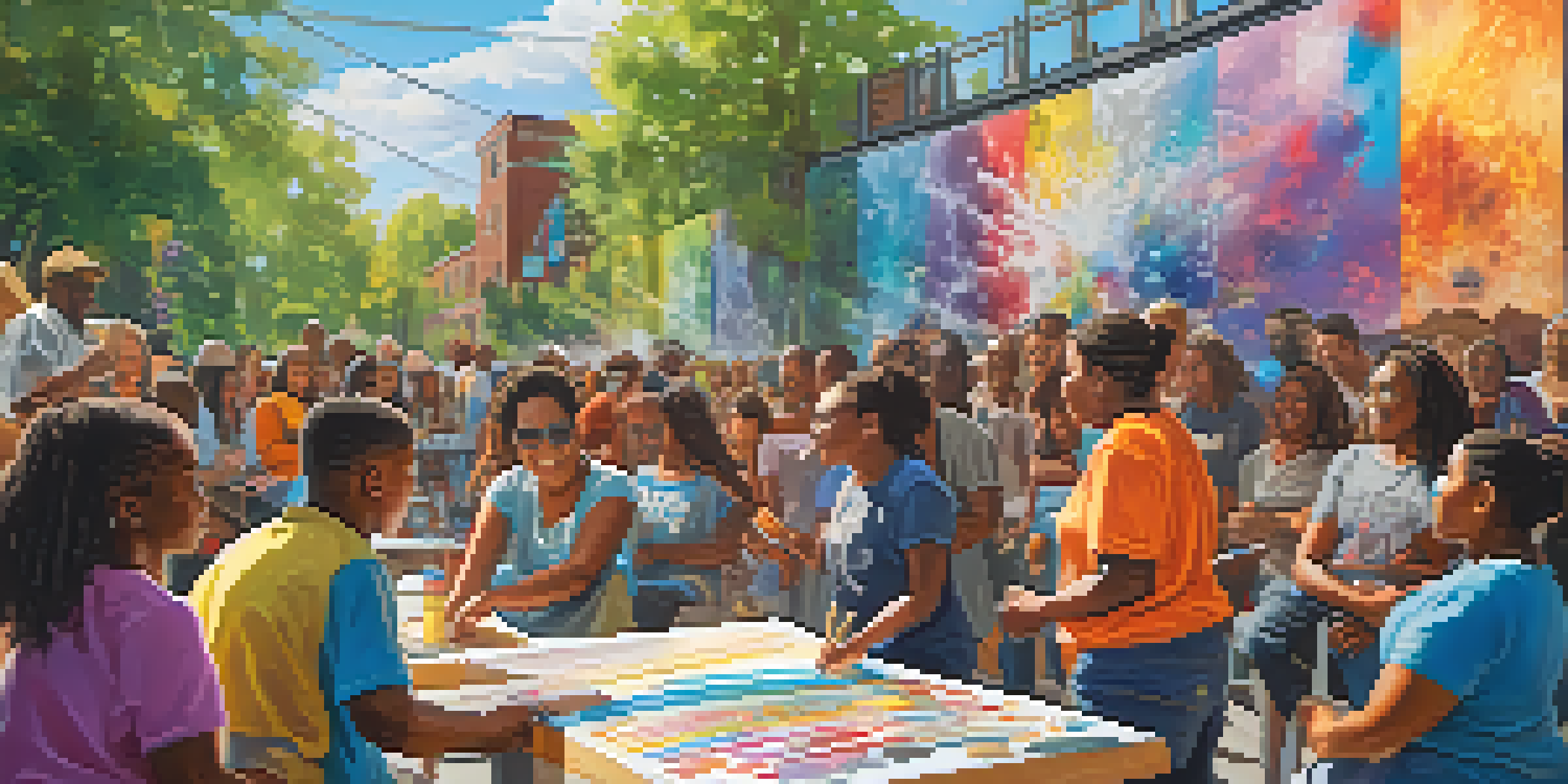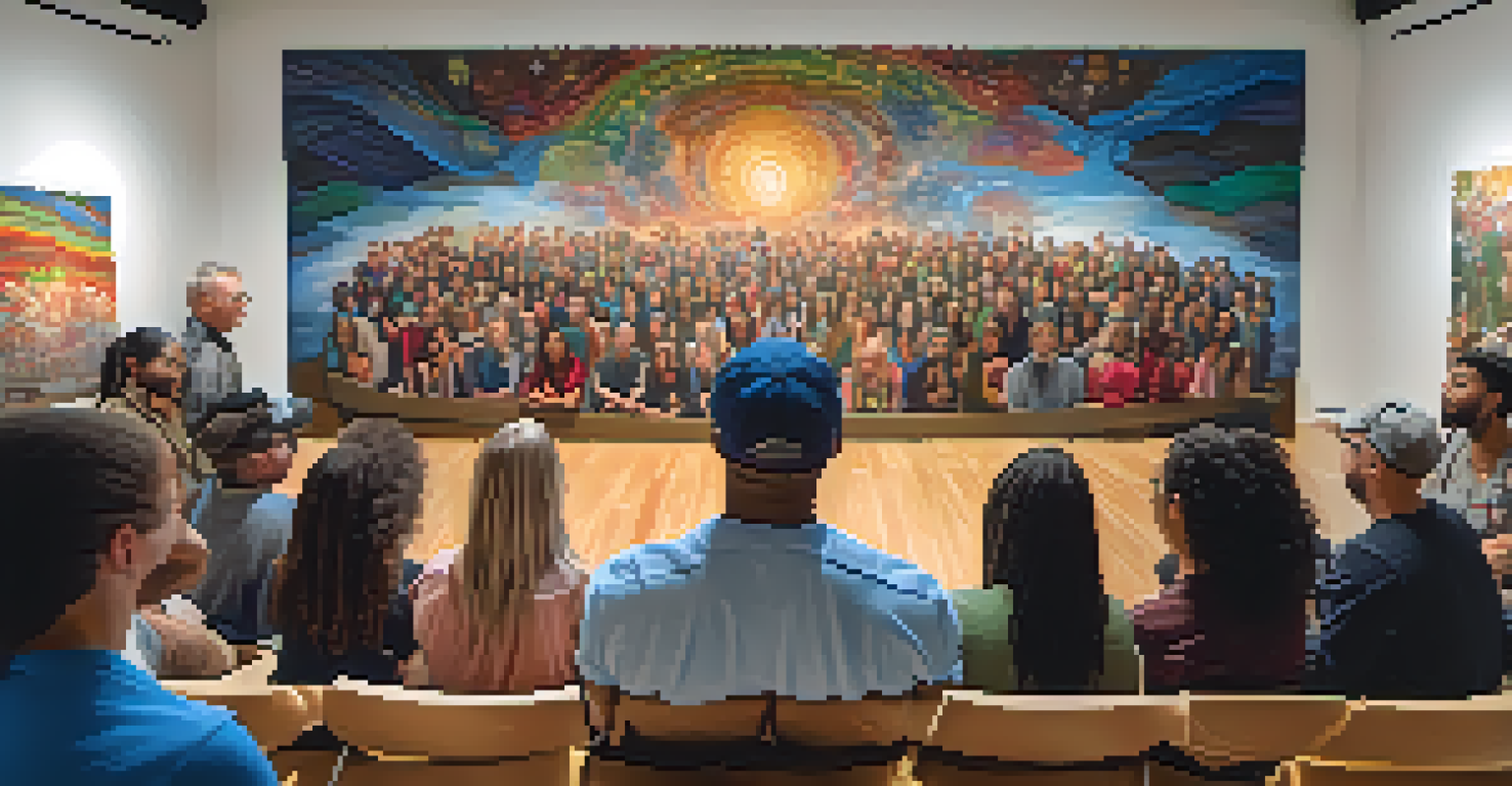Art Criticism: A Tool for Social Change in the Painting Scene

Understanding Art Criticism in Contemporary Context
Art criticism goes beyond mere evaluation; it serves as a lens through which we can understand the cultural significance of artworks. In today's world, where social issues abound, criticism can highlight the narratives and voices often overlooked. By analyzing paintings, critics can unveil deeper meanings that resonate with broader social contexts, making art a powerful tool for dialogue.
Art is not freedom from discipline, but disciplined freedom.
For instance, when a critic examines a painting addressing climate change, they not only discuss its aesthetics but also its implications on society. This dual focus invites audiences to reflect on their own experiences and responsibilities. By dissecting the layers of a piece, critics foster a greater appreciation for art that speaks to contemporary issues.
Ultimately, understanding art criticism allows us to appreciate its role in society. It encourages viewers to engage, question, and reflect on the world around them, thereby promoting a culture of awareness and change.
The Role of Artists in Promoting Social Change
Artists often act as catalysts for social change, using their work to comment on pressing issues. Through their paintings, they can challenge societal norms and provoke thought. When critics analyze these works, they help amplify the artists' intentions and the messages embedded within the art.

Take, for example, the powerful murals created during social movements. These pieces serve as visual protest, capturing the essence of collective struggles. Critics who engage with such artworks can illuminate their significance, bringing attention to the causes they represent and inspiring action among viewers.
Art Criticism and Social Issues
Art criticism serves as a lens to unveil the cultural significance of artworks, encouraging dialogue around pressing social issues.
By highlighting the role of artists in advocating for change, critics contribute to a larger conversation about art's impact on society. This partnership between artist and critic not only elevates the art itself but also fosters an environment where dialogue about social issues can thrive.
Art Criticism as a Reflection of Society
The process of art criticism is inherently reflective; it mirrors the values and concerns of society at any given time. As cultural commentators, critics have the ability to interpret how paintings reflect societal shifts, struggles, and triumphs. This reflection can be a powerful motivator for change, as it highlights the issues that need to be addressed.
Art has the power to transform, to illuminate, to educate, and to motivate.
For instance, critiques of post-colonial art often reveal the lingering impacts of colonialism on contemporary society. By discussing these themes, critics can help audiences confront uncomfortable truths and engage in meaningful discussions. This reflective nature of criticism encourages a deeper understanding of the world we live in.
Ultimately, when art criticism serves as a mirror, it can inspire collective action. By recognizing the interconnectedness of art and society, critics play a vital role in promoting awareness and fostering a sense of responsibility among viewers.
Engaging Diverse Audiences Through Art Criticism
Art criticism is not just for the elite; it should engage diverse audiences from all walks of life. By making criticism accessible, we can bridge the gap between artists and viewers, fostering a community that values different perspectives. This inclusivity can empower marginalized voices, inspiring change through collective engagement.
Critics can utilize various platforms, from social media to community workshops, to reach wider audiences. For example, a discussion about a local artist's work can draw in community members who may not typically engage with art. This approach creates a space for dialogue, where individuals can share their interpretations and connect over shared experiences.
Artists as Catalysts for Change
Artists challenge societal norms through their work, and critics amplify these messages, fostering a conversation about social change.
In this way, art criticism becomes a tool for empowerment, enabling individuals to see themselves reflected in the art they encounter. By valuing diverse voices, critics can help create a more inclusive art world that drives social change.
The Impact of Digital Platforms on Art Criticism
In the digital age, art criticism has evolved significantly, thanks to social media and online platforms. These tools offer critics new ways to share insights, reach broader audiences, and engage in real-time discussions. As a result, art criticism can now spark immediate conversations about social issues depicted in paintings.
For instance, an Instagram post analyzing a thought-provoking painting can go viral, prompting discussions that might not occur in traditional galleries. This democratization of art criticism allows for a wider range of voices, including those from underrepresented communities. Critics can highlight diverse perspectives, enriching the dialogue around social change.
Moreover, digital platforms encourage collaboration and dialogue, breaking down barriers between critics, artists, and the public. This interconnectedness can amplify the impact of criticism, fostering a culture of awareness and action where art can truly drive social change.
Challenges Facing Art Critics Today
Despite the potential of art criticism to effect change, critics often face significant challenges. The pressure to conform to market trends can stifle genuine discourse, as critics may hesitate to address controversial topics. This reluctance can undermine the role of criticism as an agent of social change, limiting its effectiveness.
Additionally, the sheer volume of art and information available online can dilute meaningful critique. Critics need to navigate this vast landscape, discerning which artworks merit deeper analysis and which may simply follow trends. This balancing act is crucial for maintaining the integrity of art criticism.
Engaging Diverse Audiences
Accessible art criticism empowers diverse audiences, bridging gaps between artists and viewers to inspire collective engagement.
Ultimately, overcoming these challenges requires a commitment to authenticity and a willingness to engage with difficult subjects. Critics who embrace this approach can revitalize their role in promoting social change through the power of art.
Fostering a Culture of Critical Engagement
To truly harness the power of art criticism for social change, we must cultivate a culture of critical engagement. This involves encouraging open dialogue, where viewers feel empowered to share their thoughts and interpretations of art. By fostering this environment, we can enhance our collective understanding of social issues conveyed through painting.
Educational initiatives, such as art workshops or discussion panels, can help demystify the process of art criticism. By providing tools and frameworks for analyzing art, we can equip individuals to engage critically with the works they encounter. This empowerment can lead to a richer appreciation of art and its societal implications.

In the end, fostering a culture of critical engagement not only enriches the art world but also strengthens our communities. When individuals feel confident in their ability to analyze and discuss art, they become active participants in the conversation about social change.